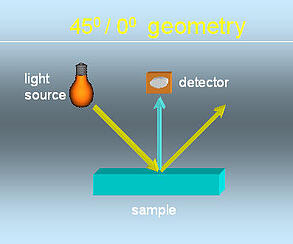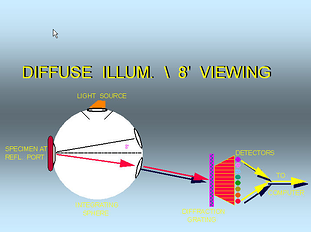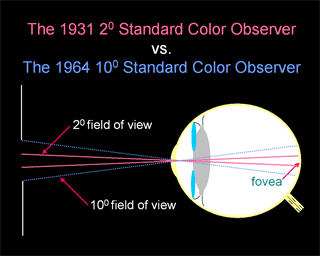Long before computers were invented a radio, film, and television comedy team known as Abbott and Costello perfected a classic skit that became known as the "Who's on First?" routine; essentially a dizzying five-minute display detailing by example the pitfalls of miscommunication via homophones, homonyms, home-run hitters, and high comedic art.
Not so funny is the frustration and confusion many working in color measurement experience due to the persistent misuse of terminology. "Why don't my color numbers match?" is a question we hear often.
The Many Angles of Color Measurement
Probably the most common misconception is about the 2° and the 10° observer. This frequently gets mixed up with the geometry of the measuring instrument with users saying they measured the color at 10° using D65 illumination, when in fact what they measured the sample with was a 45° /0° instrument using tungsten illumination. The 10° comes into play with the Standard Observer they chose for the tristimulus weighting functions.
There are two areas where these angles come into play and it's easy to see how they can become confused:
The first is the instrument geometry and how the light source and detector are positioned relative to the sample.
- The second is less obvious and goes back to how the tristimulus weighting functions are specified.

The 45°/0° refers to the geometry or optical design of the measuring instrument, be it a colorimeter or a spectrophotometer.
The most common instrument geometries used today are either 45°/0° or d/8°.
The instrument geometry is described by a pair of angles or letters. The first letter or number in the pair is for the angle of illumination; the second is for the viewing angle (or the angle that the light is detected).
So, for 45°/0°, the sample is illuminated at 45° off the normal (perpendicular to the sample) and the reflected light is viewed or detected at 0° (meaning perpendicular to the sample).

In the second example of d/8°, the ‘d' stands for diffuse illumination, meaning the sample is illuminated at all angles by diffuse light coming from the integrating sphere. (The integrating sphere is the white-coated ball collecting and diffusing the light).
The second term in d/8° stands for the angle of viewing which is 8° off the normal.
Angling for better color management
So, what are the 10° and the 2° all about?
This seems to be where all the confusion is centered. These angles refer to the Standard Observer and have nothing to do with the geometry of the instrument or the angle at which the samples are viewed.

Instead, the 10° and the 2° angles refer to the field of view when physically viewing a sample. The field of view subtends either a 2° or a 10° angle on the retina.
A better way to understand this is that a 2° field of view is equivalent to viewing a 1.7cm circle at a distance of 50cm; a 10° field of view is equivalent to viewing an 8.8cm circle at a distance of 50cm.
So roughly, the 2° field of view is equivalent to viewing a 1.7cm circle at a distance of 50cm; or like looking at your thumbnail at arms length away and the 10° field of view is like looking at the palm of your hand (or a three-inch circle) at arms' length.
The color of consistency
In industrial color control, the 10° Standard Observer is recommended because it more closely approximates the size of samples being evaluated, but you'll still find lots of standards and procedures using the 2° Observer.
These terms are important when trying to communicate color up and down the supply chain. Being able to communicate precisely how the numbers were determined is key to someone else being able to reproduce them accurately.
And now, if someday you're out at the ballpark and someone asks you, "Who's on first?" you'll know to just tell them, "Yes," and let it go at that.
